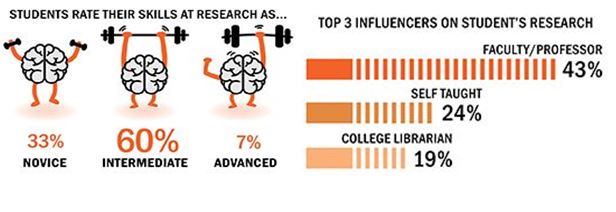EBSCO has released an infographic that illustrates their findings from a 2015 survey of 208 students about how college students conduct research. The survey focused on general research trends, how students start research, as well as the research experience. The results indicate that while students are largely receiving library instruction and using library resources, they are often challenged by or are under-utilizing certain services.
For example, nearly three-quarters (72%) of students surveyed received library instruction in college, and while students often begin their research process with Google or Wikipedia, library resources are still the most popular for conducting research, with nearly two-thirds (64%) using resources found in the library. In addition to this, well over half (60%) of the survey respondents rate their own research skills as intermediate, although very few (7%) consider themselves an expert.
Yet, even as students see the merit in library resources, many may not consult a librarian in the research process. Despite the fact that 41% of students reported that evaluating sources was their main difficulty, over half (58%) of the students would turn to the professor first if they needed help on a project, while just under a third (32%) would go to a librarian. In addition to this, the survey results suggest that college students find online research tools difficult or inconvenient. About 2 in 5 (39%) found the library’s website “challenging.” They also overwhelmingly preferred the basic search rather than the advanced option, and the students surveyed did not understand the term “database.”
This survey reveals that college and university libraries are doing a good job of reaching students with instruction, and that students still value the resources that libraries have to offer. However, libraries serving college students need to continue to promote libraries and librarians as a first point of contact for information literacy help, and need to prioritize usability, especially as students increasingly conduct their research remotely.
This infographic is packed with useful findings, and you can soak it all in here.
Note: This post is part of our series, “The Weekly Number.” In this series, we highlight statistics that help tell the story of the 21st-century library.
